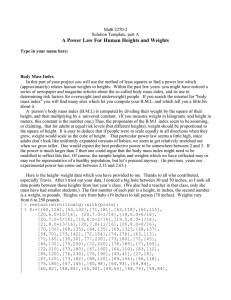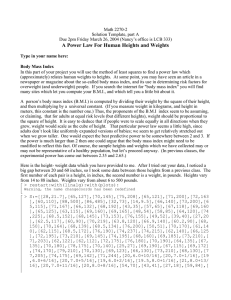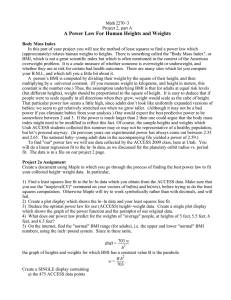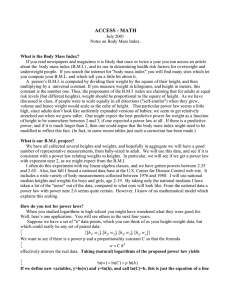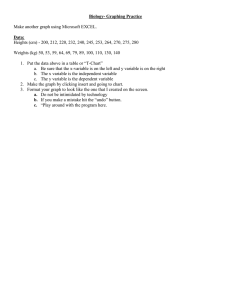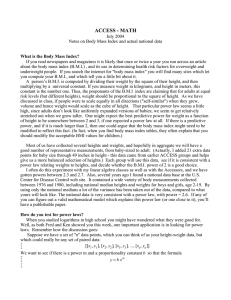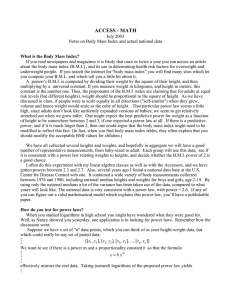A Power Law For Human Heights and Weights
advertisement
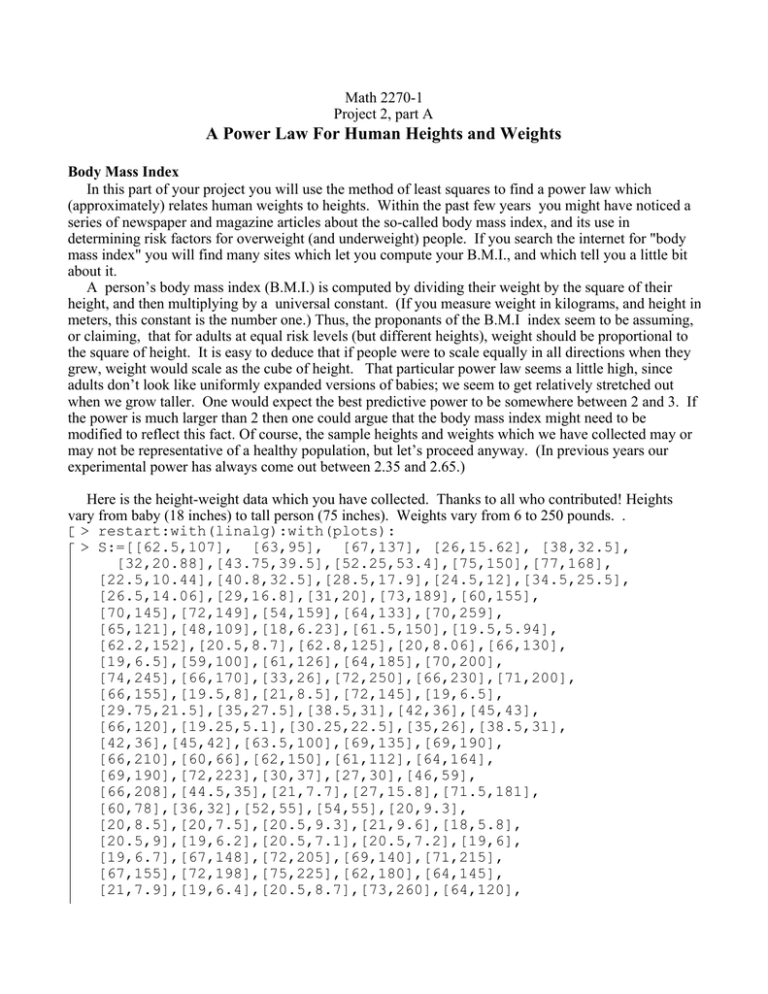
Math 2270-1 Project 2, part A A Power Law For Human Heights and Weights Body Mass Index In this part of your project you will use the method of least squares to find a power law which (approximately) relates human weights to heights. Within the past few years you might have noticed a series of newspaper and magazine articles about the so-called body mass index, and its use in determining risk factors for overweight (and underweight) people. If you search the internet for "body mass index" you will find many sites which let you compute your B.M.I., and which tell you a little bit about it. A person’s body mass index (B.M.I.) is computed by dividing their weight by the square of their height, and then multiplying by a universal constant. (If you measure weight in kilograms, and height in meters, this constant is the number one.) Thus, the proponants of the B.M.I index seem to be assuming, or claiming, that for adults at equal risk levels (but different heights), weight should be proportional to the square of height. It is easy to deduce that if people were to scale equally in all directions when they grew, weight would scale as the cube of height. That particular power law seems a little high, since adults don’t look like uniformly expanded versions of babies; we seem to get relatively stretched out when we grow taller. One would expect the best predictive power to be somewhere between 2 and 3. If the power is much larger than 2 then one could argue that the body mass index might need to be modified to reflect this fact. Of course, the sample heights and weights which we have collected may or may not be representative of a healthy population, but let’s proceed anyway. (In previous years our experimental power has always come out between 2.35 and 2.65.) Here is the height-weight data which you have collected. Thanks to all who contributed! Heights vary from baby (18 inches) to tall person (75 inches). Weights vary from 6 to 250 pounds. . > restart:with(linalg):with(plots): > S:=[[62.5,107], [63,95], [67,137], [26,15.62], [38,32.5], [32,20.88],[43.75,39.5],[52.25,53.4],[75,150],[77,168], [22.5,10.44],[40.8,32.5],[28.5,17.9],[24.5,12],[34.5,25.5], [26.5,14.06],[29,16.8],[31,20],[73,189],[60,155], [70,145],[72,149],[54,159],[64,133],[70,259], [65,121],[48,109],[18,6.23],[61.5,150],[19.5,5.94], [62.2,152],[20.5,8.7],[62.8,125],[20,8.06],[66,130], [19,6.5],[59,100],[61,126],[64,185],[70,200], [74,245],[66,170],[33,26],[72,250],[66,230],[71,200], [66,155],[19.5,8],[21,8.5],[72,145],[19,6.5], [29.75,21.5],[35,27.5],[38.5,31],[42,36],[45,43], [66,120],[19.25,5.1],[30.25,22.5],[35,26],[38.5,31], [42,36],[45,42],[63.5,100],[69,135],[69,190], [66,210],[60,66],[62,150],[61,112],[64,164], [69,190],[72,223],[30,37],[27,30],[46,59], [66,208],[44.5,35],[21,7.7],[27,15.8],[71.5,181], [60,78],[36,32],[52,55],[54,55],[20,9.3], [20,8.5],[20,7.5],[20.5,9.3],[21,9.6],[18,5.8], [20.5,9],[19,6.2],[20.5,7.1],[20.5,7.2],[19,6], [19,6.7],[67,148],[72,205],[69,140],[71,215], [67,155],[72,198],[75,225],[62,180],[64,145], [21,7.9],[19,6.4],[20.5,8.7],[73,260],[64,120], [65,140],[18.5,5.9],[19,6.3],[22,9.6],[25,11.1], [26.5,14.6],[28.8,16.2],[30,18.3],[34.8,24],[36.25,28], [40.5,33],[42,36.5],[45.5,39],[48.5,50],[52,59], [56,75],[61,98],[62,105.8],[20.75,7.8],[24,12.3], [25.5,14.5],[30,19.5],[34.5,26],[41,35],[43,39.8], [45.25,42],[47.75,50],[50.5,57],[51.8,58],[20.5,7.8], [23,12.9],[27.5,17.6],[31,23.5],[34,28],[36.5,32], [40,35.5],[42.25,39],[44,42.5],[46.5,48],[49.5,56], [51,60],[52,66],[54,73],[56,79],[59,95], [28,20]]: > A1:=convert(S,matrix): > Project 2a Assignment Create a document using Maple in which you go through the process of finding the best power law to fit your collected height-weight data. In particular, 1) Find a least squares line fit to the ln-ln data which you obtain from A1. 2) Create a plot display which shows the ln-ln data and your least squares line fit. 3) Deduce the optimal power law for our class height-weight data. Create a plot display which shows the graph of the power function and the pointplot of our original data. 4) What does your power law predict for the weights of "average" people, at heights of 5 feet, 5.5 feet, 6 feet, and 6.5 feet? 5) On the internet, find the "normal" BMI range (for adults), i.e. the upper and lower "normal" BMI numbers, using the inch-pound system. Since in these units, BMI = 703 w h2 the graph of heights and weights for which BMI has a constant value B is the parabola 1 B h2 w= . 703 Create a single display containing our original data points, our power law curve, and the upper and lower parabolas for the "normal" BMI range. You can use different colors to identify the various curves. Our power law and the BMI curves should both fit the adult data pretty well. Explain why most children don’t fit into the "normal" BMI range, based on our calculated power law and how it compares to a power law with p=2. How are the BMI standards adjusted for children? Is this consistent with our data? Note: It turns out a Belgian demographer, Adolphe Quetelet, also called the "Father of Statistics", originally proposed a power of p=2 for adults, based on his own data analysis during the early 1800’s. In a footnote which history has forgotten, he said that a power of 2.5 is more appropriate if you want an approximation for people of all ages.
